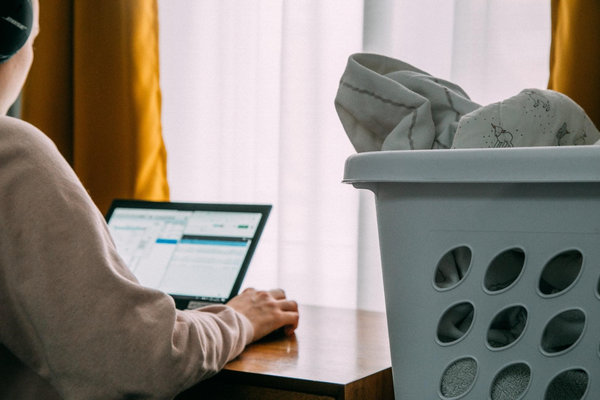Is it possible that cleaning products could be “dirty”? In a sense, that could be the case if you’re using laundry detergents with strong chemicals like ammonia and chlorine. Besides the cleaning products themselves, there are also other eco-friendly actors. They include cleaning products being packaged in non-recyclable containers, which are related to the most recent recycling statistics.

Let’s take a look at some top ways to do zero-waste cleaning and laundry.
#1 Read and Understand Labels
It can be tough to sift through a cleaning product’s ingredients list when we don’t know exactly what chemicals they contain. Here’s an example. Besides reading and pronouncing “Perchloroethylene” being a challenge, what in the world is it?
A related issue is the Environmental Protection Agency (EPA) rarely requires testing for such ingredients. So it can be tough to determine how “green” a certain ingredient is. In many cases, the EPA hasn’t given a particular ingredient a red flag even though it’s unhealthy.
Read Labels
This issue is more complex than it might seem. One issue is most people don’t have the chemistry know-how to determine what’s actually been added to their cleaning/laundry products. So while a certain ingredient might sound safe or even natural, most of us don’t really know.
Then there are misleading terms that are added to product labels, including “natural.” In some situations, the ingredients are as such, but in others, they’re basically toxic chemicals. This is a completely different issue than “certified organic” products, for example.
Proper Disposal
If you already have cleaning products with possibly toxic chemicals, make sure they’re disposed of safely and properly. This can help to minimize the environmental impact and carbon footprint they create.
Here are some of the most dangerous chemicals to watch out for:
- 2-Butoxyethanol
- Ammonia
- Chlorine
- Formaldehyde
- Perchloroethylene (PERC)
- Sodium Hydroxide
#2 Make Green Cleaners and Laundry Detergents
Along with recycling product containers, this is one of the best ways to make your cleaning zero-waste. This provides several benefits besides natural cleaners, including:
- Using natural cleaning products
- Minimizing packaging waste
- Reusing jars and spray bottles
7 DIY Cleaners (video)
Basic Ingredients
One of the main benefits of making DIY cleaners is they’re generally limited-ingredient. This not only saves you money but also reduces how much of the stuff you’ll have to add to your homemade cleaners.
Here are some common ingredients you can use for making your cleaning mixtures:
- Baking Soda
- Borax
- Castile Soap
- Citric Acid
- Hydrogen Peroxide
- Lemon Juice
- Washing Soda
- White Vinegar
You can also use essential oils to add a fresh scent to your DIY cleaning products. These are highly concentrated oils extracted from plants like rose, lavender, and peppermint. Just a few drops can make your cleaning products smell like fresh flowers.
#3 Use Existing Cleaning Gear
While it might seem you need fancy gear for cleaning stuff around your home or office, it’s simply not true. In this case, “the old ways are the best ways” rule is true.
Avoiding Fancy Gear
It turns out you can do effective cleaning without lots of fancy cleaning gear that might break soon after you start using it. In fact, the existing cleaning gear around your home is quite durable. This includes:
- Brooms
- Buckets
- Drying Racks
- Drying Racks
- Dusters (Extendable)
- Dustpans
- Hair Catchers
- Hampers
- Irons
- Pan Scrapers
- Toilet Brushes
- Vacuum Cleaners
These items can still break. However, in general if you buy quality items then they should last quite a while. Besides that, you can also recycle or reuse ones made of materials like wood and plastic, for example.
Finding, Fixing, and Reusing
Another method to make your cleaning zero-waste is to find and fix existing cleaning gear. For example, you might have lots of unused items stored in your closet. Besides that, a handyman can try to fix broken items so you can keep using them and avoid turning gear into waste.
\Yet another option is to reuse cleaning gear. Some good sources include Craigslist and local thrift stores. Even friends and family might have some cleaning equipment that they’re not using yet needs a home.
#4 Pick Clothes and Linens with Natural Fibers
This might be a surprising option since it’s not related to laundry detergent or fabric softener. What’s it all about? Well, you can make certain choices to make sure all your laundry is plastic-free.
Fibers to Ocean
Here’s what happens. When you use clothing with synthetic fibers, tiny pieces shed off when you wash the garment or linen. Then those tiny fibers wash down the drain.
It might seem that local treatment plants would filter out the tiny fibers. In theory, they would. However, the fibers are actually too tiny for the plants to do that. So they go straight to the ocean.
If you pick shirts, pants, and socks made with natural fibers, then you can prevent waste from going directly to Earth’s oceans. Some biodegradable fibers include:
- Cotton
- Linen
- Silk
- Hemp
If you want your laundering to be “green” then avoid synthetic fibers like:
- Polyester
- Nylon
- Rayon
- Acrylic
These fibers are basically plastic since they function like plastic.
What Are Natural Fibers & Why Should You Wear Them? (video)
#5 Do Eco-Friendly Laundering
Besides picking natural fibers from the get-go, you can also take some basic steps to minimize waste when washing clothes and linens. Here are some helpful tips:
- Wash in cold water to reduce energy costs
- Spot-clean stains to delay full washings.
- Air-dry clothes instead of using the dryer
- Wash full loads to reduce wasted natural resources
- Use the proper dosage of natural laundry detergent.
Conclusion
While zero-waste cleaning and laundering might seem impossible, it’s actually a thing. They include steps like using natural cleaning products, durable cleaning gear, and natural fibers. Boosting the most recent recycling statistics and saving precious natural resources are just some of the many big benefits. Clean green!
Author:

Lillian Connors is a Senior Content Developer at ACT-ENVIRO, with years of experience in developing content.
Throughout her career, she always looked for ways to contribute to the environment in recycling efforts, while providing valuable information with her written articles.
She’s deeply into green practices, cherishing the notion that sustainability not only makes us far less dependent on others regarding how we live and do business but also contributes to our planet being a better place to live on. When she is not trying to improve the things around her (and herself, for that matter), she likes to lose herself in a good book and sip on an occasional appletini.
